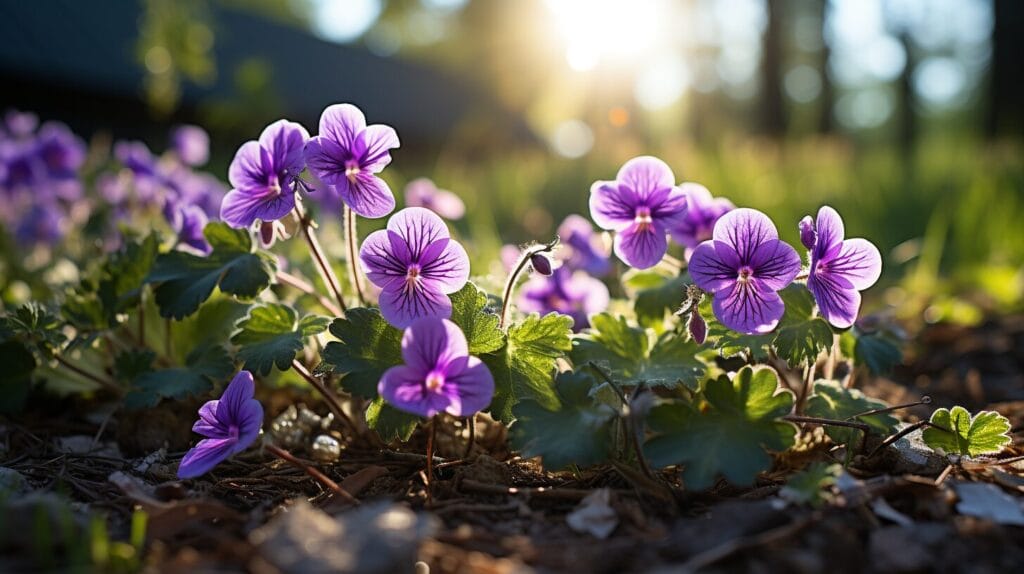Creeping Charlie, a persistent botanical invader, cunningly weaves its tendrils through our backyard greenery without any solicitation, disturbing the harmony of our lush gardens. We recognize the annoyance it brings and are prepared to offer well-researched approaches for handling it. Let’s explore both classical and tactical herbicide applications to keep our gardens free from these deceptive Creeping Charlie plants and their beguiling purple blooms.
Stay with us as we unveil a comprehensive plan to turn the tide in your fight against Creeping Charlie.
Key Takeaways
- Recognize Creeping Charlie by its kidney-shaped leaves and purple flowers.
- It competes with turfgrass for resources, risking lawn health.
- Control methods include selective herbicides and maintaining healthy lawns.
- Preventative measures include ensuring sunlight, proper drainage, and regular lawn care.
Understanding Creeping Charlie (Glechoma Hederacea) in Your Lawn

Identifying Creeping Charlie, scientifically known as Glechoma hederacea, is the first step to managing its spread. With distinct kidney-shaped leaves and small, funnel-shaped purple flowers, this perennial weed is aggressive and invasive.
A dense, healthy lawn is the best defense against Creeping Charlie. It thrives where grass is weak, so maintaining turf health is essential. If an infestation occurs, consider a lawn weed killer for broadleaf weeds, especially those with dicamba or triclopyr. Apply herbicides when Creeping Charlie is actively growing, in spring or fall, for the best results.
Risks and Effects of Creeping Charlie on Lawn Health

Creeping Charlie poses a threat to lawn aesthetics and health. It competes with turfgrass for water, sunlight, and nutrients, strangling grassroots and creating bare spots. The dense mats block sunlight, stifle grass growth, and create disease-friendly conditions.
Eradication is challenging due to its vigorous growth and propagation. An infestation often indicates soil fertility or pH issues. Proactive management is crucial to prevent Creeping Charlie from overwhelming your lawn.
Effective Strategies to Control Creeping Charlie in Lawns

Combining regular mowing with chemical interventions is key. Mowing prevents flowering and spreading but is insufficient alone.
Effective control methods include:
- Selective Herbicides: A postemergence broadleaf herbicide with triclopyr targets Creeping Charlie without harming the grass.
- Timing of Application: Apply herbicides when the weed is actively growing, in fall or spring.
- Maintenance and Prevention: A thick, healthy lawn discourages Creeping Charlie. Feed, aerate, and overseed to prevent its establishment.
A diligent, persistent approach is necessary due to the weed’s resilience. Integrating maintenance with herbicide use can effectively control Creeping Charlie.
Preventive Measures to Avoid Creeping Charlie Infestation

Cultivating a robust lawn is essential for preventing Creeping Charlie. Ensure plenty of sunlight by pruning trees and shrubs, and improve drainage in moist areas. A healthy lawn ecosystem is the best defense.
| Lawn Health Aspect | Benefit of Preventing Creeping, Charlie |
|---|---|
| Dense Turf Grass | Limits space and light for weed growth |
| Smart Watering | Discourages moist conditions |
| Soil Fertilization & Aeration | Enhances grass health, outcompeting weeds |
Water your lawn deeply but infrequently, and regularly fertilize and aerate to maintain a healthy turf that resists Creeping Charlie.
Alternatives to Creeping Charlie Control: Incorporating it into Your Landscape

Creeping Charlie can be embraced for its ecological benefits, such as supporting pollinators. Consider designating a natural area for it, using it as a garden border, or creating a pollinator haven. This balanced approach can lead to a harmonious coexistence in your garden.
-Can Sprinkling Grass Seed Help Control Creeping Charlie in Your Lawn?
Yes, using grass seed for lawn repair can help control creeping Charlie. This method promotes healthy grass growth, which can outcompete the invasive weed. Proper lawn maintenance, including regular watering and fertilizing, can also help keep creeping Charlie at bay. Overall, lawn repair simplified with grass seed is a cost-effective and natural solution.
Conclusion
We have explored the challenge of Creeping Charlie, offering knowledge and strategies for its control. By maintaining our lawns or integrating the weeds thoughtfully, we can achieve a healthy, vibrant turf, free of this invasive plant.
Frequently Asked Questions
How Do I Get Rid of Purple Flower Weeds in My Lawn?
Eliminate purple flower weeds with selective herbicides, dense turf maintenance, and pre-emergent treatments.
What Kills Creeping Charlie weeds with purple flowers Naturally?
Vinegar, hand-pulling, and mulching are natural methods effective against Creeping Charlie.
Does Creeping Charlie Have Purple Flowers?
Yes, Creeping Charlie has purple flowers that bloom in late spring to early summer.
Is There a Weed and Feed That Kills Creeping Charlie?
Some weed and feed products containing dicamba are effective against Creeping Charlie. Always check product labels.







